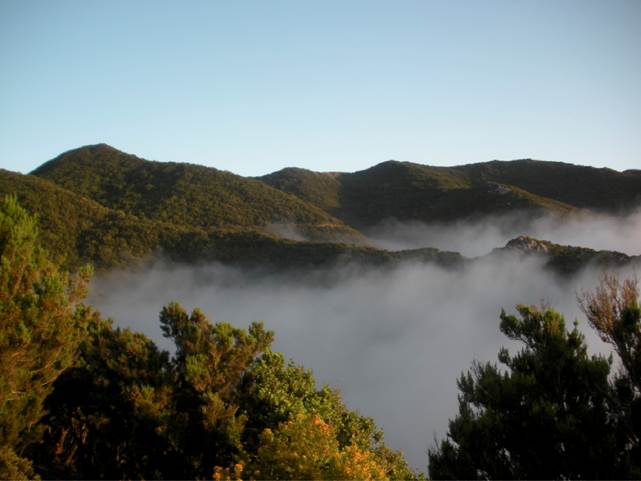
Ecological Archives E096-192-A2
María C. Rodríguez-Rodríguez, Pedro Jordano, and Alfredo Valido. 2015. Hotspots of damage by anatgonists shape the spatial structure of plant–pollinator interactions. Ecology 96:2181–2191. http://dx.doi.org/10.1890/14-2467.1
Appendix B. Description of the study site and the replicate patches.
Habitat
Teno Alto is located in the Teno massif, one of the oldest geological sectors of Tenerife (5.6–6.2 million years, Guillou et al. 2004). This locality, included in the protected area of Teno Natural Park, is characterized by an abrupt orography exposed to constant and intense winds and high insolation. Climate is Mediterranean, with hot and dry summers and mild winters. Mean annual precipitation is over 350 mm, with most of it falling between November and March. Annual average temperature is 19.4°C, with January being the coldest month (Marzol-Jaén, 1984).
The predominant vegetation is ‘fayal-brezal’ forest (Fig. B1). This forest represents a transitional stage of laurel forest located in its upper distributional limit. Its abundance is a consequence of the intense human disturbance (forest logging, farming and grazing activities) that swept away the original laurel forest in the locality. Thus, the ‘fayal-brezal’ has lower species richness compared to laurel forest, with a canopy dominated by the most pioneering tree species: Erica arborea L. (Ericaceae), Morella faya (Aiton) Wilbur (Myricaceae) and Ilex canariensis Poir. (Aquifoliaceae).Among the understorey species, the rockrose Cistus monspeliensis L. (Cistaceae) was the most frequent shrub coflowering with our study species, Isoplexis canariensis (L.) J. W. Loudon (Plantaginaceae). All plant species are pollinated by insects except Canarina canariensis (L.) Vatke (Campanulaceae), which is a vertebrate-pollinated creeper that flowers in winter (Rodríguez-Rodríguez and Valido 2011).
Replicate patches
To collect the data, we mapped all the adult reproductive plants of I. canariensis present in two replicate patches, approximately 50 m apart (patch 1: 8.9 × 13.7 m, 67 individuals; patch 2: 17.5 × 19.70 m, 52 individuals; Fig. B2).
In the study area, there are several patches with similar conditions to the selected replicates. Most of them are very close together, although separated by natural barriers, e.g., rocky outcrops or forest fragments. We selected these close replicates for three main reasons: (i) to include a representative distribution of individual plants in nature (Fig. B2, see also Appendix E: Fig. E1A), (ii) to avoid highly contrasting conditions across I. canariensis individuals in climate, habitat structure, and composition of the surrounding plant community. In this way, we potentially control for these alternative factors and reduce their relative impact on PRS compared to the net effect of plant-animal interactions. Finally, (iii) for logistical reasons. Many patches are inaccessible because of the abrupt relief present in Teno massif, what makes it a region abundant in ravines and cliffs quite difficult for fieldwork.
Inside each studied patch, we mapped all the reproductive plants, excluding recruits, seedlings and juveniles from the analysis. Plants were spatially closer in patch 1 (averaged nearest neighbor distance: 54.6 ± 48.1 cm) than in patch 2 (90.6 ± 80.4 cm). In total, we monitored 119 adult plants, 384 inflorescences, and 8478 floral pedicels that included open flowers and floral buds that did not develop into open flowers.
Fig. B1. Summits of Teno Alto covered by ‘fayal-brezal’ forest (Teno Rural Park, Tenerife, Canary Islands). Note the sea of clouds blown by the northeast trade winds. Photo credits: M. C. Rodríguez-Rodríguez.
Fig. B2. Patchy distribution of Isoplexis canariensis in the replicate plots 1 (A) and 2 (B). The most frequent coflowering species was Cistus monspeliensis (Cistaceae) with white, insect-pollinated flowers (foreground in patch 1). Photo credits: M. C. Rodríguez-Rodríguez.
Literature cited
Guillou, H., J. C. Carracedo, R. Paris, and F. J. P. Torrado. 2004. Implications for the early shield-stage evolution of Tenerife from K/Ar ages and magnetic stratigraphy. Earth and Planetary Science Letters 222:599–614.
Marzol-Jaén, M. V. 1984. El clima. Pages 28-83 in L. Afonso, editor. Geografía de Canarias. Interinsular Canaria, Santa Cruz de Tenerife, Spain.
Rodríguez-Rodríguez, M. C., and A. Valido. 2011. Consequences of plant-pollinator and floral-herbivore interactions on the reproductive success of the Canary islands endemic Canarina canariensis (Campanulaceae). American Journal of Botany 98:1465–1474.